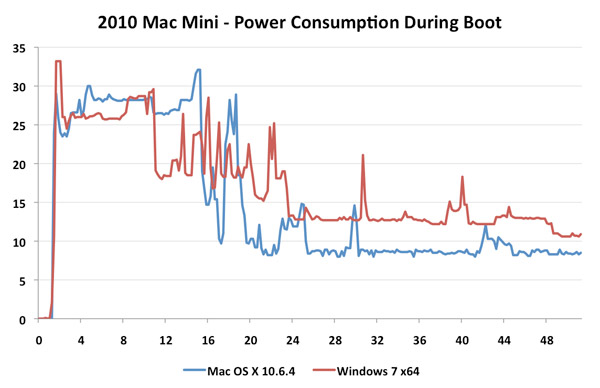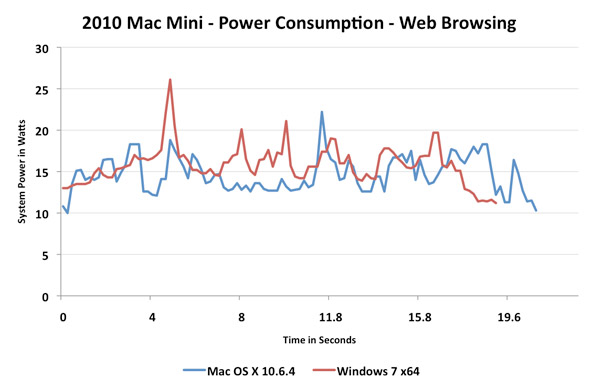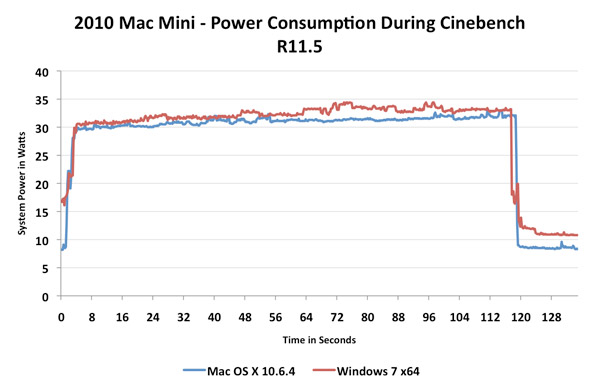Apple Mac mini Review (Mid 2010)
by Anand Lal Shimpi on August 9, 2010 3:37 AM ESTHonest Apple & Energy Efficiency
Apple calls the new Mac mini the world’s most energy-efficient desktop computer. I thought that might be a bit of a stretch but if you look at the numbers, they’re very convincing.
Zotac’s HD-ID11, an Atom based next-generation ION nettop, idles at 21.7W. Even the ASUS UL50V notebook, with a Core 2 Duo SU7300 (1.3GHz) ultra low voltage notebook CPU idles at 8.1W with the screen disabled.
Now that 8.1W number is unrealistic for a notebook. The screen was disabled, battery removed, WiFi disconnected and no ethernet cables plugged in. If I run the 2010 Mac mini in a similar configuration (minus the display/battery part since, well, they don’t exist), the entire system consumes 7.5W at idle.
Connect to a WiFi network, plug in an Ethernet cable and you’re looking at 8W. I have not seen a modern desktop machine idle at lower power than the 2010 Mac mini.
| 2010 Mac mini Power Usage | ||||||||
| Idle | Half Life 2 Episode Two | DVD Playback | Web Browsing | Quicktime Encode | Cinebench R11.5 | |||
| Apple Mac mini (Mid 2010) | 8.0W | 26.4W | 16.1W | 8.6W - 19W | 30.3W | 30.0W | ||
Part of this has to do with Apple’s very efficient integrated PSU. Unlike the other two systems I mentioned here, the mini uses a custom, integrated 85W PSU specifically designed for the system’s load.
Part of it has to do with Apple’s component selection. The mini is built entirely out of notebook parts with a custom motherboard design devoid of anything unnecessary. I’ve even heard that Apple goes to great lengths to ensure the CPUs/GPUs/chipsets it gets are on the lower power portion of the yield curve for products like the mini or MacBook Air.
The third explanation for why Apple is able to make such a bold claim about the Mac mini’s power consumption has nothing to do with hardware at all. As we’ve shown in the past, Mac OS X tends to offer better battery life than Windows in situations where the system sees a lot of idle time. Reading web pages, typing a document, etc... all tend to expose this advantage. Under load however, the OS X power advantage disappears - we are after all dealing with the same components regardless of OS.
The idle battery life advantage comes from lower idle power, presumably through heavy OS and hardware optimization. While I measured 8W at idle under OS X, running Windows 7 (power saver mode) on the Mac mini resulted in a 12W idle power without any changes to the hardware. Granted I don’t have identical hardware by another manufacturer to confirm that this isn’t negligence on Apple’s part to optimize its firmware for Windows 7. However in the past we’ve shown that systems from Lenovo, despite having similar specifications to Apple notebooks deliver worse idle battery life. I believe it’s safe to assume that part of the reason Apple is able to make such a bold claim about the mini’s energy efficiency is because it is the only desktop that can be sold running Mac OS X.
I recorded the mini’s power consumption over time running both OS X 10.6.4 and Windows 7 x64 to give you an idea of where the power consumption differences come into play.
This first chart shows power consumption during the boot process. From power on until you get a cursor at the desktop and the system’s power draw stabilizes for a while. The red line is Windows 7, the blue line is OS X:

Peak power consumption is nearly identical between the two OSes during the boot process. However, OS X drops down to idle sooner (finishes booting quicker) and remains at a lower idle point than Windows 7. Both OSes experience blips of activity after we reach the desktop as additional services are started.
The next test is some basic web browsing using Chrome. I loaded the AnandTech front page, scrolled to an article, clicked on it, scrolled down to the comments and recorded system power consumption:

I tried to get both runs as close as possible to one another, but I am human. Even while browsing the web the CPU has ample time to go into lower power states. Total platform power dips lower under OS X and is lower overall.
Our final test shows a run of Cinebench R11.5. The legend is the same, red for Windows, blue for OS X, but this time the CPU is pegged at 100% for the duration of the test:

The two systems are nearly identical in terms of power consumption. OS X still offers a slight advantage that’s consistent but not pronounced. The render completes in approximately the same amount of time in both OSes, although Windows is a hair quicker. The mini under OS X scored 1.38 points vs. 1.39 under Windows 7.
Since there is a performance difference here, it could just be that Apple is optimizing for power consumption rather than peak performance in the OS itself. It’s difficult to analyze but it’s something I am seeing fairly consistently.










93 Comments
View All Comments
DaveGirard - Tuesday, August 10, 2010 - link
seriously - I use a Mac Pro Nehalem for Maya and if I had to build a network of headless slaves, this would be an expensive and underperforming option. You could make a vanilla i7 for less and it would destroy this machine for rendering. Nice to see this is a great mini server/HTPC but it's not for performance.name99 - Tuesday, August 10, 2010 - link
Why would you engage in such a stupid enterprise?Apple is NOT selling you a bunch of MIPs here at the lowest possible cost. They are selling you a device that runs MacOSX, with IO options adequate for most users, that is low power and small.
If you do not need any of these capabilities, then buying such a computer is stupid.
Or, to put it another, don't buy a package of, what, 10GFlops AND a reasonable quality GPU AND two video ports AND FW8000 AND OSX AND a small form factor, and then complain that the package costs more than this other package consisting of 10GFlops and nothing else.
But if this device meets your needs, it's great --- I got a previous gen mini for HTPC, and it does what it is meant to do, at a price I found acceptable.
JAS - Monday, August 9, 2010 - link
I bought one of these to run a public kiosk display (Apple Keynote program on a loop). Beyond its good looks, the new Mac Mini provides more than enough horsepower for what most "normal" people use computers for -- web browsers, media playback, e-mail, word processing and so forth. I like how access to the RAM has been made easy and the addition of the HDMI and SD connectors.My only significant criticism of the new Mac Mini is its retail price. It ought to be $50 to $100 less to be considered an "entry level" Macintosh.
nafhan - Monday, August 9, 2010 - link
I agree from a computing aspect, but it really ought to be about $200 - $300 less to be considered a good computer for the average home user. Especially since they will have to spring another $100+ for a monitor/mouse/keyboard right off the bat.Steve W - Monday, August 9, 2010 - link
The idea behind the Mac Mini is that you DON'T have to spring for a "monitor/mouse/keyboard" if you are the average switcher. If you need a monitor, then the iMac is a better buy.Ratman6161 - Tuesday, August 10, 2010 - link
Given that it does not come with those items? The only way you would not need them is if you just happened to already have them. But if you were buying this as a second computer etc that might not be the case.tipoo - Friday, September 10, 2010 - link
Exactly. Once you add a monitor, keyboard and mouse into the price, you are into iMac price territory, and the iMac is still alot faster.LtGoonRush - Monday, August 9, 2010 - link
I don't understand why 7200rpm 2.5" HDDs aren't more popular. The cost difference isn't very large, on a 320GB drive it only amounts to $5. The performance difference isn't Earth-shattering, but given the price of the system it seems hard to justify cutting this corner, along with shaving off 2GB of RAM as called out in the review.Minion4Hire - Monday, August 9, 2010 - link
I've heard both power and noise concerns given as reasons (besides cost as you mentioned) why 7200s aren't as popular. Both are pretty minor, but those are valid reasons.Shark Tek - Monday, August 9, 2010 - link
The main reason of why they aren't popular is a very valid one.HEAT...
A good example is one about the PS3 HD upgrade. They recommend 5400rpm disks due to problems of overheating using a faster one.